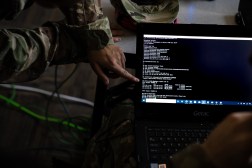New Pentagon program to speed up software acquisition set to launch May 1

The Defense Department’s chief information officer will kick off a new program this week that aims to overhaul cumbersome bureaucratic mechanisms and streamline its ability to rapidly approve new software capabilities for warfighters.
Under the Software Fast Track (SWIFT) program, the Pentagon will use artificial intelligence to replace legacy authority to operate (ATO) and Risk Management Framework (RMF) processes when buying new software. Acting DOD CIO Katie Arrington signed a memo authorizing the new effort, and it will officially launch May 1, she said.
“We need to change our thought process, because having software in an ATO that is a static environment doesn’t help the warfighter,” Arrington said Tuesday during a keynote at the UiPath on Tour Public Sector event, produced by FedScoop. “What changes every single day is the network, the software [and] the environment. Why are we so structured to stay in a static position when our adversaries are always dynamic?”
As the Pentagon becomes more dependent on software-based capabilities, leaders have looked to pivot away from traditional ATO frameworks encumbered by lengthy administrative processes and manual paperwork that can stifle modernization. Some organizations have begun exploring continuous authority to operate (cATO) methods, which use automated monitoring and security controls to approve software without need for reauthorization.
Instead, SWIFT will do a third-party assessment of companies’ cybersecurity postures based on 12 risk characteristics. Vendors will also be required to provide a software bill of materials (SBOM) “from production and sandbox” that is certified by a third party, Arrington said.
“I have AI on the backside — large language modeling — that will determine if there are any anomalies, if there’s something in your source code that’s bad. If not, you get a provisional ATO,” she said.
Arrington added that SWIFT will allow the department to pivot away from the current RMF, a structured set of guidelines used to identify and manage potential cybersecurity risks on networks. For more than a decade, the framework has guided the Pentagon’s acquisition process for all of its systems — from development to sustainment.
“I’m blowing up the RMF. The RMF is archaic, it’s a bunch of paperwork,” Arrington said. She added that in the next year, she hopes that ATOs are “something I never hear about again.”
SWIFT comes as Secretary of Defense Pete Hegseth is pushing the entire department to speed up procurement and delivery of digital and software-based capabilities. In March, Hegseth issued a memo that calls on Pentagon leaders to use innovative acquisition authorities — from the Software Acquisition Policy to commercial solutions openings — to rapidly buy software.
“We need more innovation. The [secretary of defense] has told us, bring software, bring [commercial-off-the-shelf] into the building faster, at a more rapid rate,” Arrington said. “And our job is to ensure that we are doing the best to ensure that we have lethality, that we’re ready and that we’re efficient.”
When the program launches, Arrington said she plans to bring together all of the department’s CIOs, chief information security officers, the acquisition and sustainment directorate and other stakeholders at the Pentagon. In the near future, the department plans to release a request for information (RFI) to gather industry input.






